
HAYDOCK CATHOLIC BIBLE COMMENTARY ON THE OLD TESTAMENT
LEVITICUS 8
CHAPTER VIII.
Ver. 2. Bread. This basket stood near the altar of holocausts, in the court. Most part of this chapter has been already explained. Exod. xxix.
Ver. 7. Garment, subucula, which is styled a strait tunic. Ex. xxviii. This was girded close, while the upper garment (máil) was fastened by the ephod, contrary to what Josephus and others have asserted. C. --- Truth. When the ephod and rational were joined together, God gave his oracles, 1 K. xxiii. 9. No woman could wear the ornaments, which were made by divine wisdom. S. Cyril in Lev. xiii. 6. W.
Ver. 9. Sanctification. Having these words engraven on it, Holiness to the Lord.
Ver. 12. Head. To shew that he was the fountain of the priesthood, and that power was derived from him.
Ver. 13. Linen. Aquila translates "inward." It was next to the skin. --- Mitres, caps. Ex. xxviii. 4. These were the garments of priests. Those of the Levites are not particularized. About six years before the destruction of the temple by Titus, the Levites obtained of Agrippa leave to wear the linen tunic, which was deemed a great innovation, seldom left unpunished. Joseph. Ant. xx. 8.
Ver. 14. Calf. This ceremony was repeated for seven days, v. 33. C. --- At the same time, Moses consecrated the altars and all the furniture of the tabernacle, v. 10.
Ver. 23. Foot. The whole person was thus sensibly consecrated to God's service. H. --- The pagan high priest, among the Romans, was adorned in silk and ribbands, with a crown of gold. Being conducted under ground, the blood of an ox, which had been sacrificed, came upon his head, ears, and other parts of his body, through little holes, made in a board; and thus besmeared, he was recognized by the people. Prudent. hym. S. Romani, Saumaise. &c.
Ver. 27. Who having. Moses supported and directed the hands of the priest.
Ver. 30. Vestments. It is a maxim among the Rabbins, that a priest without his vestments, is not considered as such; and he is put to death, if he should dare to approach the altar in that condition. When the priests lay aside their sacred robes, they are looked upon as laymen. C. --- The high priest was consecrated by the unction on the head; (v. 12,) those of an inferior condition, were sprinkled with ointment mixed with blood, &c. M.
Ver. 33. Finished. During this time, some say they were allowed to go our for a short time, to satisfy the calls of nature; while others say they were to continue always in the tabernacle, or in the court. Afterwards the priests on duty continued all the time in the temple, adorned with their sacred robes. The high priest could not wear his on other occasions, except some very urgent affair require it, as was the case when Jaddus went to meet Alexander. C.
Ver. 34. Done...so. The Heb. adds, "the Lord hath commanded to do, to make atonement for you." H.
Ver. 35. Watches. They might be permitted to take a little sleep during part of this week. T. --- In: Heb. "at the door of the tabernacle of the assembly, attentive to the ordinances of the Lord." H. --- Die, as Nadab did afterwards. Moses officiated as the consecrating priest. One of the most venerable of the order, consecrated the successors of Aaron. Some assert, that they only invested him with the pontifical robes. Num. xx. 25. 1 Mac. x. 21. C. --- The power of Moses was extraordinary; that of Aaron was ordinary, designed to continue in after ages. S. Aug. q. 23. None must presume to take this office of priest, but such as are called by God. Heb. v. Those of the old law, were initiated by sacred rites or sacraments, which signified the grace of God, requisite to perform their duties well. They were chosen from among men, to be more holy; of which their washing was a sign, as their splendid robes were to remind them of their sublime dignity and authority over the people. The high priest had seven special ornaments: 1. white linen, to denote purity; 2. a curious girdle, intimating that he must use discretion in all things; 3. the long tunic of various colours, with bells, &c. signifying heavenly conversation upon earth, union and harmony in faith and morals; 4. an ephod, with two precious stones on the shoulders, teaching him to support the failings of the multitude; 5. the rational, with its ornaments, shew that the pontiff should be solicitous to teach sound and profitable doctrine; 6. the mitre indicates, that all his actions should be referred to God above; and lastly, the plate of gold denotes that he should have God always in view, and never forget that consummate holiness which He requireth. See S. Jerom ep. ad Fabiol. --- The three ornaments of the priests, put them in mind of purity, discretion, and a right intention, to be observed in all their conduct. On this occasion, a change was introduced in the priesthood, as the law was new; the first-born being obliged to give place to Aaron's family. Thus, when these were deprived of the exclusive privilege, and people from any family were chosen by Christ, the law of Moses ceased to exist. Heb. vii. The ordination of the former was a figure of that sacrament, by which Christian priests still receive grace and power. 2 Tim. i. Theod. q. 48. Num. S. Aug. de bono conj. 24. W.
Copyright ©1999-2023 Wildfire Fellowship, Inc all rights reserved

 Keep Site Running
Keep Site Running